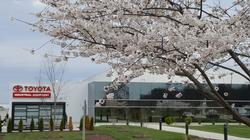
Toyota’s environmentally-friendly manufacturing process
5559 Inwood Dr
P.O. Box 17419
Columbus, IN 47201
Phone: 800 226-0009
Fax: 949 223-8007
http://www.toyotaforklift.com
Toyota operates under a global earth charter that promotes environmental responsibility throughout the entire company. Toyota Industrial Equipment Manufacturing (TIEM) is responsible for manufacturing the majority of Toyota forklifts sold in North America. Making processes more green is a consideration in every process change or manufacturing improvement.
Here are five ways TIEM makes its manufacturing processes environmentally-friendly:
- Toyota forklifts are manufactured at TIEM, a zero-landfill facility.
- TIEM requests suppliers use environmentally-friendly materials and processes in products supplied to Toyota.
- TIEM requires its top 65 suppliers – who account for more than 85% of the materials purchased locally – to be ISO 14001 certified or have an equivalent EMS (Environmental Management System).
- The water sent back to the water treatment facility in Columbus, Indiana, (home to TIEM) is cleaner than required by government standards.
- TIEM made improvements to its paint operations, which includes the conversion of 50% of the painting processes over to powder coat and the addition of paint robots in other areas to improve transfer efficiency of solvent based paints.
Environmentally-friendly manufacturing at your own facility
Toyota is committed to continuously improving our own environmental stewardship, and we ask our partners to do the same. Instituting recycling programs, minimizing pollution, and promoting the advantages of electric-powered forklifts are just a few considerations that make a difference.
What can you do?
There are a number of ways you can help your facility become more environmentally friendly and help reduce your operating costs. Something as simple as changing your thermostat can make a big difference. Allowing the temperature range in your facility to be a little warmer in the summer months and cooler in the winter months can have a positive impact on the environment and reduce your company’s overall carbon footprint – and your energy bill!
After changing your thermostat, inspect your lighting system. Is it energy-efficient? Using LED lights can certainly help.
You can also increase your number of alternative fuel forklifts, whether electric, propane or Compressed Natural Gas (CNG). Propane, for example, is non-toxic and clean-burning, so it’s versatile enough for indoor or outdoor applications. It’s also safe, economical, and requires little maintenance. Also consider recycling used oil.
If you work with partners or vendors, inspire them to adopt green initiatives as well. And if you’re finding your parking lot is looking pretty full, encourage carpooling among employees and offer incentives for doing so.
Using the Toyota Production System to achieve environmentally-friendly manufacturing
Toyota established a policy to reduce CO2 emissions, use resources more efficiently, and reduce environmental risk factors. Throughout its wide range of activities, Toyota always considers the environment as part of its daily operations. The policy is to analyze effects at each stage of a products’ life: development, manufacturing, operation, and recycling.
Toyota Production System (TPS) philosophy also includes the 3Rs: Reduce. Reuse. Recycle.
With respect to manufacturing, the reduction of waste (muda) is one of the key principles and, therefore, benefits of TPS. Reduction of waste in processing, inventory, conveyance, overproduction, motion, waiting, and manufacturing defects delivers direct environmental benefits.
At a lower level, waste sorting has long been practiced at Toyota’s manufacturing plants and Toyota’s forklift plant in Columbus, Indiana, where the majority of Toyota forklifts are built, has achieved ISO 14001 certification.
Three ways to eliminate waste in environmentally-friendly manufacturing
Cutting back on waste is often a long-term goal with multiple short-term steps. Here are a few of the steps you can take to get started:
- Minimize waste by recycling and looking at your process to reduce the amount of raw materials used.
- For remaining waste, consider a waste-to-energy facility. Is there a way to reuse the waste that was created?
- Consider implementing a recycling program at your facility. Set goals for reduction in waste that goes to landfills.









